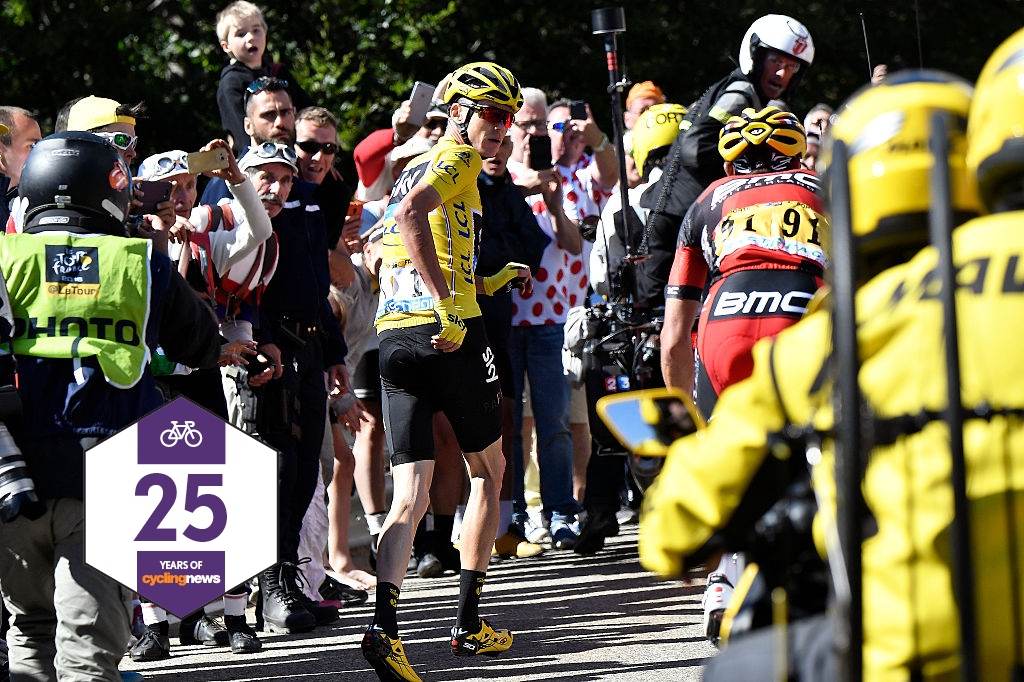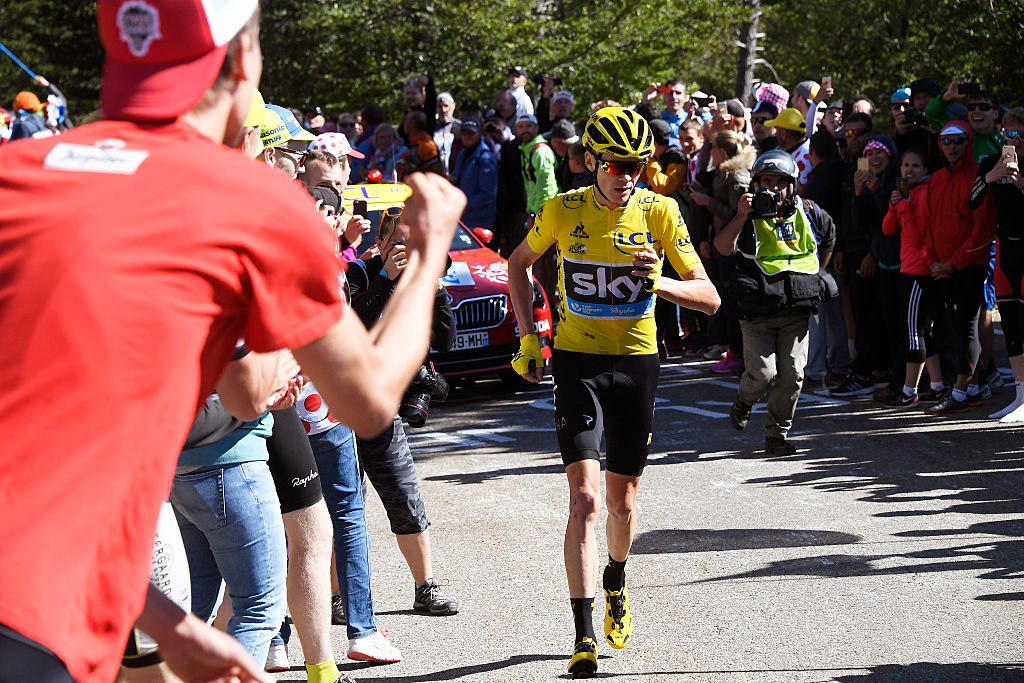Running after Chris Froome on Mont Ventoux
Remembering a tumultuous afternoon on the 2016 Tour de France

The front cover of the July 15, 2016 edition of L’Equipe was a keeper. Chris Froome, in the yellow jersey, on foot, running up Mont Ventoux. Alongside his jutting elbows and panicked expression, the headline: ‘Du Jamais Vu’ – ‘never seen before.’
The 2016 Tour de France was hardly a vintage edition, as a whole, but that one moment will never be forgotten.
It was the first Tour I covered on the ground, and my third stage there after flying out on the first rest day. The day started out calmly enough. Splitting resources between the press room and the finish line, which had been moved down to Chalet Reynard due to high winds, one of my colleagues and I hitched a lift up the ‘Giant of Provence’ with Procycling editor Ed Pickering. Ed put on a rival podcast over the bluetooth but otherwise it was smooth sailing.
When we reached Bedoin, however, everything changed. It sounds trite, but there was something in the air, carried along on the Mistral wind that was barrelling into the mountainside at 70kph. It was carnage, right from the moment the gradient tilted uphill. The narrow road winding up through the trees was reduced to a thin sliver of tarmac by the hordes of fans. The decision to move the finish down from the exposed peak effectively crammed in a full complement of Bastille Day fans into half the space.
Grown men in mankinis blocked the road and pounded our rental car with their fists. Ed gave the clutch and the horn an equal run for their money. “Whatever you do, do not open your window,” came the command from the driver’s seat. It was firm, yet anxious, laced with some unspoken past trauma. I didn’t ask, but when the yellow contents of a plastic pint cup landed on the windscreen, I think I understood.
Somehow, we made it out of the treeline at Chalet Reynard safe, dry, and in a car that was still fully functional. Things did calm down for a while as we sheltered and watched the race in the small media truck, but when we emerged outside again for the finish there was something intangible in the air once more – a tension and a vague sense of confusion. Again, I’m not sure if that recollection is reliable or if it’s hindsight colouring in the gaps in my memory.
Either way, Thomas De Gendt crossed the line first and there was a ripple of excitement but the main course was still to come. I could have sworn I heard the podium announcer say that Froome was proceeding on foot. I’m not sure whether it was a lack of faith in my French or just simple disbelief, but I didn’t really take it on board at the time. Even so, the announcer was growing more and more excitable and it was clear something unusual and dramatic was happening.
Get The Leadout Newsletter
The latest race content, interviews, features, reviews and expert buying guides, direct to your inbox!
When the riders reach the finish line, they stop pedalling, but for everyone waiting on the other side the race is only just beginning. It’s an explosion of activity as reporters, press officers, soigneurs, and gendarmes sprint left right and centre.
I chased Romain Bardet up the hill and grabbed some vague quotes but soon saw the crowds gathering outside the Team Sky bus and hurried over. It was there that whispers of what had happened – the motorbike crash, the broken bike, the run – started to circulate. We waited nearly 45 minutes for Froome, only to learn his time loss had been neutralised and he was still in yellow. He was behind the podium 250 metres away. Cue stampede.
After being booed while receiving his yellow jersey, Froome emerged from behind the podium and made his way over to the anti-doping truck. By now, everyone had their eyes on the same story, and he was trailed by a sprawling, rolling maul of a media pack. In he went, and outside we waited. Reporters jostled for position, camera men muscled their way to the front.
My colleague Sadhbh O’Shea was told by one that this area was reserved for journalists. I don’t know why he assumed she couldn’t be a journalist, but I can have a guess. Either way, her reply was as sharp as her elbows (to this day I’ve never seen someone so adept at navigating a media scrum as Sadhbh, who would wade into the most tangled mess of limbs and somehow always manage to pop her dictaphone out at the front).
On this occasion, however, there was nothing to record. After more than half an hour, Froome emerged from anti-doping and walked past us, not speaking and barely bothering to lift his head. He wasn’t going to the media truck for the yellow jersey’s mandatory post-stage press conference, having limited himself to a brief exchange with France Télévisions before the podium ceremony. The press conference truck was now already being dismantled, and Froome instead walked straight over to a Team Sky car and was driven up and over the famous peak.

In a race founded by a newspaper, the yellow jersey’s daily engagements with the press have become something of a sacred rite, not least since repeated doping scandals eroded public trust. Froome’s relationship with the media was, however, already heavily strained. The public atmosphere of suspicion from the 2015 race had carried over, and while the siege mentality of Froome and Sky’s media approach had been toned down, there was still an apparent reluctance to engage fully with the press.
Froome didn’t speak, but everyone else did. Why were there so many fans in the final kilometre? Why were there no barriers? Why was the motorbike not already well out of the way? Why was Froome awarded the same time as Richie Porte and Bauke Mollema?
Debate raged, but as we were writing up all these opinions in a small hotel in the middle of nowhere, they were rendered trivial by the breaking news that a lorry driver had killed 84 of people in a terror attack in Nice, barely 200km away. The Tour awoke in sombre mood in the Ardèche on July 15, and the question had to be asked over whether the race should continue.
After Ventoux, the rolling stage 13 time trial was the second crucial stage in a row, in terms of the battle for the yellow jersey, but the racing itself was oddly insignificant. Froome effectively sealed the Tour that day, but it felt almost inconsequential.
For the riders as well as us reporters, it was tricky to navigate the situation with the respect it deserved. How can you ask about the intricacies of the race when such a loss of human life – and threat to our way of life as a whole – is still so fresh? I remember being in a huddle where one rider was asked about disc wheels. I find tech talk tiresome at the best of times but here it just seemed completely out of place. On the other hand, giving the narrative over entirely to the events in Nice risked becoming platitudinous.
No one seemed to know quite how to proceed, and Froome once again declined to take questions, instead limiting his yellow jersey press conference to one statement on the attacks in his adopted home city. This time, it was hard to complain.
If no one knew quite what to say, then in the end it was silence that sent the strongest message. For the podium ceremony, there was no pounding music, cheering crowds, or excitable announcer. Instead, the special jersey wearers – Froome in yellow, Peter Sagan in green, Adam Yates in white, and De Gendt in polka-dots – were brought out together for a perfectly-observed minute’s silence. It was a hugely powerful moment.
The poignancy contrasted sharply with the polemics and drama of the previous afternoon. We’d been whipped up into the maelstrom of the Tour and spat back out immediately, reminded of the irrelevance of sport in the grand scheme of things. But we were also reminded of the importance of sport in the grand scheme of things. The Tour de France is as close to a national symbol you can get and the fact that the show rolled on, albeit subdued in tone, felt like a meaningful statement of defiance.
The L’Equipe cover the following day was also a keeper – Froome in yellow with a black armband on a page that faded to black, with the simple headline: ‘L’Émotion’.
As an aspiring journalist, it was something of a dream to go and cover the Tour de France. The reality is that, on a practical level, it’s the event many cycling writers least look forward to – high on stress and short on access. Still, the Tour is the Tour, as they say, and when it transcends the sport in that way, you can’t help but appreciate being part of such a special event.
As we saw on Ventoux and the following day, the Tour de France is a world away from a controlled sporting production in a sealed arena. It’s a living, breathing organism, moving in real time with the real world, with 21 stages and a precise roadmap but with infinite possible storylines.
Patrick is a freelance sports writer and editor. He’s an NCTJ-accredited journalist with a bachelor’s degree in modern languages (French and Spanish). Patrick worked full-time at Cyclingnews for eight years between 2015 and 2023, latterly as Deputy Editor.
